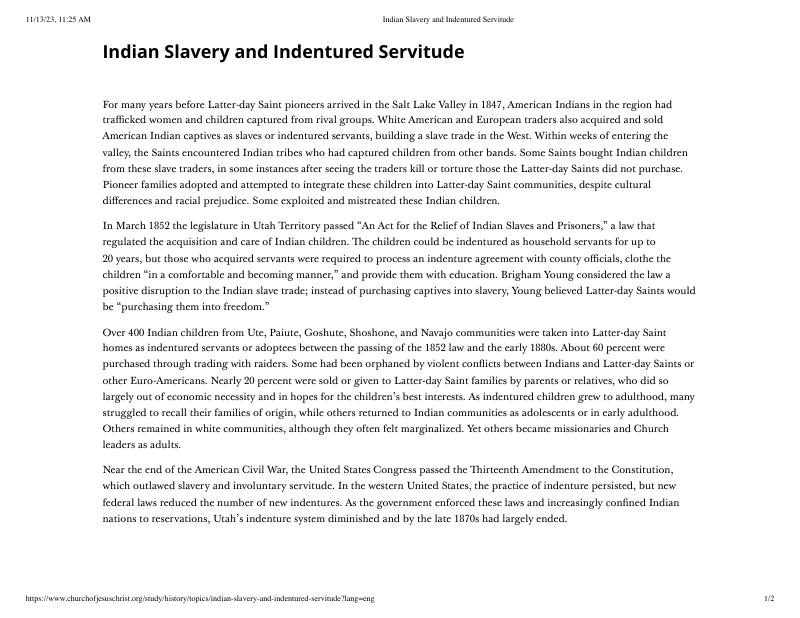Church History Topic essay gives brief history of Indian slavery in Utah.
- Type
- Website
- Source
- The Church of Jesus Christ of Latter-day Saints LDS
- Hearsay
- Secondary
- Reference
"Indian Slavery and Indentured Servitude," Church of Jesus Christ of Latter-day Saints, accessed November 13, 2023
- Scribe/Publisher
- The Church of Jesus Christ of Latter-day Saints
- People
- The Church of Jesus Christ of Latter-day Saints
- Audience
- Internet Public, The Church of Jesus Christ of Latter-day Saints
- Transcription
Indian Slavery and Indentured Servitude
For many years before Latter-day Saint pioneers arrived in the Salt Lake Valley in 1847, American Indians in the region had trafficked women and children captured from rival groups. White American and European traders also acquired and sold American Indian captives as slaves or indentured servants, building a slave trade in the West. Within weeks of entering the valley, the Saints encountered Indian tribes who had captured children from other bands. Some Saints bought Indian children from these slave traders, in some instances after seeing the traders kill or torture those the Latter-day Saints did not purchase. Pioneer families adopted and attempted to integrate these children into Latter-day Saint communities, despite cultural differences and racial prejudice. Some exploited and mistreated these Indian children.
In March 1852 the legislature in Utah Territory passed “An Act for the Relief of Indian Slaves and Prisoners,” a law that regulated the acquisition and care of Indian children. The children could be indentured as household servants for up to 20 years, but those who acquired servants were required to process an indenture agreement with county officials, clothe the children “in a comfortable and becoming manner,” and provide them with education. Brigham Young considered the law a positive disruption to the Indian slave trade; instead of purchasing captives into slavery, Young believed Latter-day Saints would be “purchasing them into freedom.”
Over 400 Indian children from Ute, Paiute, Goshute, Shoshone, and Navajo communities were taken into Latter-day Saint homes as indentured servants or adoptees between the passing of the 1852 law and the early 1880s. About 60 percent were purchased through trading with raiders. Some had been orphaned by violent conflicts between Indians and Latter-day Saints or other Euro-Americans. Nearly 20 percent were sold or given to Latter-day Saint families by parents or relatives, who did so largely out of economic necessity and in hopes for the children’s best interests. As indentured children grew to adulthood, many struggled to recall their families of origin, while others returned to Indian communities as adolescents or in early adulthood. Others remained in white communities, although they often felt marginalized. Yet others became missionaries and Church leaders as adults.
Near the end of the American Civil War, the United States Congress passed the Thirteenth Amendment to the Constitution, which outlawed slavery and involuntary servitude. In the western United States, the practice of indenture persisted, but new federal laws reduced the number of new indentures. As the government enforced these laws and increasingly confined Indian nations to reservations, Utah’s indenture system diminished and by the late 1870s had largely ended.
The B. H. Roberts Foundation is not owned by, operated by, or affiliated with the Church of Jesus Christ of Latter-day Saints.

